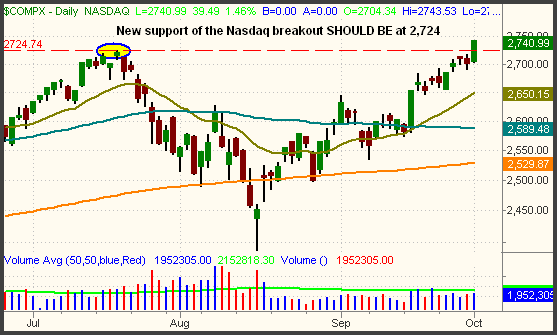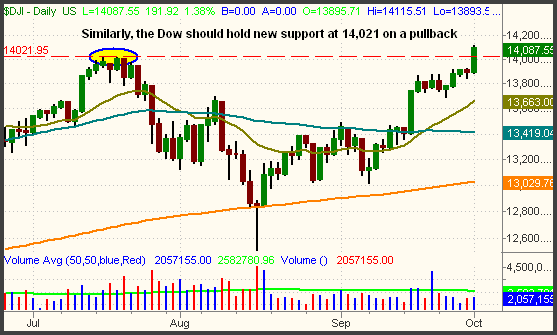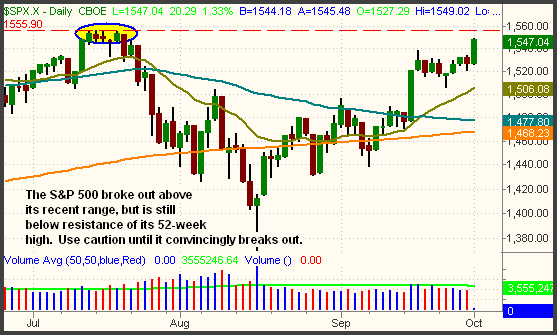| The Wagner Daily ETF Report for October 2 |
| By Deron Wagner |
Published
10/2/2007
|
Stocks
|
Unrated
|
|
|
|
The Wagner Daily ETF Report for October 2
The first day of the fourth quarter got off to a promising start, as stocks posted strong gains across the board. After several weeks of choppy trading, it was also the first day in which the major indices trended steadily higher throughout the entire session. The Nasdaq Composite scored a 1.5% advance and closed at a new six-year high. The Dow Jones Industrial Average did one better by rallying 1.4% and settling at a fresh all-time high. The S&P 500 gained 1.3%, but was unable to penetrate its prior high from July. The Russell 2000, which has been toying with its pivotal 200-day MA for quite some time, finally resolved itself to the upside, at least for now. The benchmark small-cap index surged 2.4%. The S&P Midcap 400 was higher by 1.4%. Though there was a bit of a pullback in the final thirty minutes, all of the main stock market indexes still managed to finish near their intraday highs.
Slightly higher turnover in both exchanges helped to validate yesterday's advance. Total volume in the NYSE increased 6%, while volume in the Nasdaq came in 2% above the previous day's level. The "accumulation day" marked by the higher volume broad-based gains was positive considering that last Friday's session was a bearish "distribution day." Still, trading remained below 50-day average levels. With both the Nasdaq and Dow breaking out to new highs, one might have expected a stronger show of buying interest. Over the past six weeks, both the NYSE and Nasdaq have had only two days in which turnover registered above average levels. Market internals were solid. Advancing volume in the NYSE exceeded declining volume by just over 4 to 1. The Nasdaq ratio was positive by more than 3 to 1.
The Nasdaq Composite broke out above resistance of its prior 52-week high that we discussed in yesterday's commentary. As such, its prior high from July should now act as new support. Over the next several days, one could expect a test of support of the breakout level. If yesterday's move to a new high is to "stick," the Nasdaq should not dip much below the 2,724 level. Failure to hold above that level would put the Nasdaq in jeopardy of a false breakout. New support of the breakout level is marked by the horizontal line on the Nasdaq daily chart below:

The same scenario is true of the Dow Industrials, which motored to untouched record high territory. New support of the prior high from July is shown on the daily chart of the Dow:

The big question is whether or not the broad-based S&P 500 will follow the Nasdaq and Dow to a new high. Though it broke out of its two-week trading range, it closed about seven points shy of its July high. We expect an imminent test of that pivotal resistance level within the next few sessions. If it clears it, the breakouts in the Nasdaq and Dow will likely hold above their breakout levels as well. If it doesn't, prepare for volatile and indecisive overall trading conditions:

Despite the new highs in the Nasdaq and Dow, most industry sector and specialized ETFs are now pushing against the upper edge of their primary uptrending channels. We hesitate to use the word "overbought," as stocks and ETFs that are "overbought" can remain that way for weeks on end before correcting. Still, in scanning the chart patterns of hundreds of ETFs, we came across very few that now offer a positive risk/reward for new entry on the long side. Conversely, short selling is no longer a good bet with the Nasdaq and Dow at new highs. So, what's a trader to do? We suggest shifting into SOH mode.
"SOH" is an acronym for "sitting on hands." The term is reserved for periods in which one detects only minimal trading opportunities with a positive risk/reward ratio. When I began my trading career many years ago, I mistakenly thought that professional traders needed to be active in the markets every day. I felt that I wasn't doing my job if a day passed in which I didn't look for new trade entries. But I soon realized the hard way that my thought process was wrong. The epiphany came when I discovered I was often giving back many weeks, or even months, of hard-earned profits within a very short span of time. Through studying my trading records, I noted the culprit nearly every time was overtrading during periods of mixed signals from the stock market.
The reality is that the most consistently profitable professional traders are actually out of the markets more than they are in the markets. They, of course, are very aggressive when times are good, loading up on promising trade setups, but they step aside when the picture is not so clear. Part of the job of a professional trader is knowing when to be SOH and do nothing. It is our humble opinion that now is one such time, especially considering the S&P 500 is just below resistance of its 52-week high. We've had quite a profitable run over the past several months, and don't intend to give it back.
Open ETF positions:
Long - LQD
Short - (none)
Deron Wagner is the Founder and Head Trader of both Morpheus Capital LP, a U.S. hedge fund, and Morpheus Trading Group, a trader education firm launched in 2001 that provides daily technical analysis of the leading ETFs and stocks. For a free trial to the full version of The Wagner Daily or to learn about Wagner's other services, visit MorpheusTrading.com or send an e-mail to deron@morpheustrading.com.
|